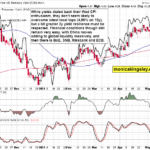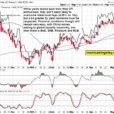

Introduction: A Trader’s Guide to Strategic AdaptabilityThe dynamic world of options trading demands traders possess a versatile mindset, akin to that of a chess grandmaster, always thinking several moves ahead. Among the myriad of strategies available, rolling over options is a pivotal manoeuvre, enabling traders to navigate unexpected twists and turns in their quest for success. Imagine yourself in a bustling financial market, armed with the wisdom of trading legends and the prowess to adapt to unforeseen events. This essay delves into the intriguing strategy of rolling over options. A technique savvy traders employ to manage positions that deviate from their initial expectations.Throughout history, renowned traders have emphasized the importance of adaptability and risk management. Reminiscent of Sun Tzu’s ancient wisdom, “Amid the chaos, there is also an opportunity,” rolling over options presents a unique chance to turn potential losses into strategic gains. This guide will take you on a journey through the minds of trading icons, revealing their secrets to embracing market fluctuations with finesse. Prepare to unlock the mysteries of rolling over options and discover how this tactic empowers you to navigate the options market with the agility of a master strategist.
Understanding the Rollover Strategy
The options market is a dynamic arena that requires traders to be adaptable and quick on their feet. One essential technique in an options trader’s toolkit is rolling over options, a strategy employed when positions move against initial expectations. Imagine you’ve sold January 25 puts with a strike price of $17.50, but the underlying stock unexpectedly drops to $16.00. This is where the magic of rolling over comes into play, allowing you to manage your trade without taking ownership of the stock if that’s not your primary objective.In the given scenario, you could consider rolling out your position to mitigate potential losses. This involves a two-step process: buying back the $17.50 puts you’ve sold and simultaneously selling puts with a lower strike price, such as $15.00. By selecting a lower strike price, you create a buffer against further losses if the stock continues its downward trajectory.However, there’s a catch. Moving to a lower strike price often necessitates extending the expiration date to receive a comparable premium. Depending on your market assessment and investment timeline, this could mean selling June 2025 $15 puts or even January 2026 $15 puts. Rolling over allows you to adjust your position based on your current market outlook and risk tolerance.
Benefits of Rolling Over
Flexibility Rolling over options provides the strategic advantage of managing trades with agility. It allows traders the freedom to pivot without the commitment to stock ownership, affording them the crucial time needed to reassess and adapt to fluctuating market conditions.Risk Management: Opting to roll to a lower strike price introduces a protective buffer zone. This strategic move shields you from escalating losses, offering a safety net should the stock continue its downward trajectory.Time Value: By extending the expiration date of your options, you capitalize on the time value inherent in options trading. This provides the stock with additional time to rebound and align with your market predictions and enhances your chances of a favourable outcome, maximizing the potential benefits of your investment.
Wise Words from Trading Legends
Rolling over options aligns with the wisdom of trading legends throughout history. Reminiscing on the words of the 16th-century trader and author Joseph de la Vega, “He who sells what isn’t his’n, must repurchase it or go to prison” underscores the importance of managing risk and understanding the implications of your trades. Fast forward to the 20th century, and we have Nicolas Darvas, a renowned dancer-turned-trader, who emphasized, “I never let my losses run. I might let my profits run, but I always cut my losses short.” Here, we see the value of proactive risk management, a core principle of rolling over.More recently, a top trader and author, Mark Minervini, has encouraged traders to “Make your money work hard for you. You have to be open to taking calculated risks and putting your money in situations where it can grow.” Rolling over options embodies this mindset, allowing you to reposition your capital for potential growth while managing risk.
Mass Psychology and Technical Analysis
The success of rolling over options heavily relies on understanding mass psychology and technical analysis. By interpreting market sentiment and historical price patterns, traders can make informed decisions about when and how to roll over. Technical indicators such as support and resistance levels, volume trends, and chart patterns help identify strategic strike prices and expiration dates for the new options. Combining this with an understanding of market psychology enables traders to anticipate potential turning points and adjust their positions accordingly. Practical Application of Rolling OverLet’s return to the example of the unexpected stock drop. If you’re comfortable owning the stock at the lower price of $16.00, you could let the assignment happen and acquire the shares. From there, you have options: hold the shares, anticipate a price rebound, or sell them immediately at the current market price. If you choose to sell, you can sell new puts, generating premium income and potentially re-entering a stock position later.The Greeks—Delta, Theta, and Vega—play a pivotal role in options pricing. Delta measures the rate of change in the option’s price relative to the underlying stock’s price. Theta reflects the time decay of an option’s value, and Vega represents the sensitivity of the option’s price to changes in volatility. Understanding these factors is crucial when rolling over, as they influence the pricing and behaviour of options contracts.
Conclusion: Mastering the Art of Flexibility in Options Trading
Rolling over options is not merely a tactic; it’s an essential strategy for the shrewd trader. It serves as a compass to navigate through the tumultuous seas of the options market with confidence and precision. This powerful tool demands a proactive stance in monitoring ever-shifting market conditions and a robust understanding of the intricate dynamics of options pricing.By skillfully blending the timeless wisdom of trading titans with the cutting-edge insights of mass psychology and the meticulous precision of technical analysis, traders are equipped to make decisions that are not just informed but transformative. Rolling over options allows traders to dance gracefully with market volatility, turning potential threats into lucrative opportunities.Remember, options trading is akin to a high-stakes game of strategy and skill. It demands more than just making wise choices; it requires a mastery of risk management and an adaptive mindset that thrives on the ever-evolving market landscape. As you harness the power of rolling over options, you step into a realm where flexibility and strategic foresight lead to triumph, ensuring you survive and thrive in the trading world. Embrace this journey with both the zeal of a newcomer and the sagacity of a seasoned trader, and watch as your trading portfolio transforms through strategic adaptability.More By This Author:Current Market Sentiment Indicators: Spotting Market Moves
Exposing The Truth Behind The Infamous Label: Millennials Really Are Dumb
IBM Stock Price Forecast 2024: Examining IBM’s Strategic Vision
















